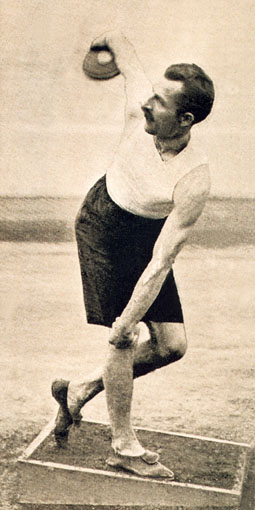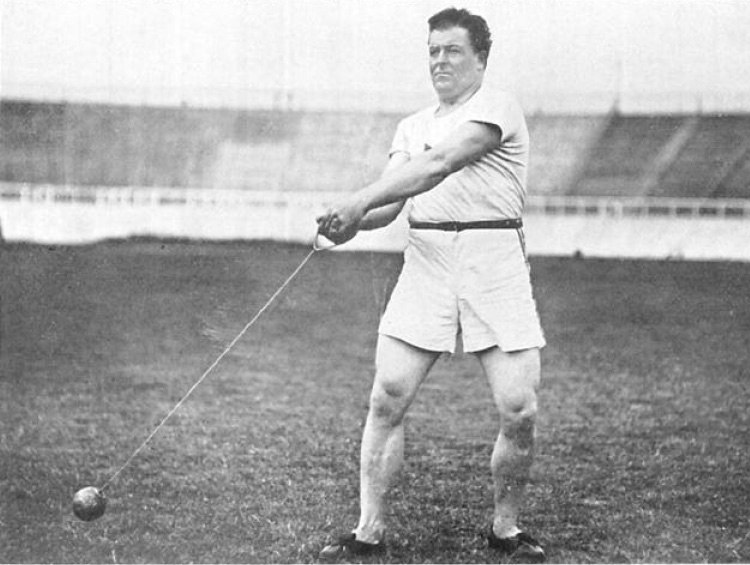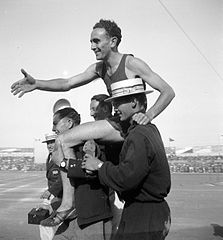Enhance your health with free online physiotherapy exercise lessons and videos about various disease and health condition
Old Athletes
Old athletes are generally less flexible and have smaller muscle masses, lower aerobic capacities, and less well-tuned thermoregulatory mechanisms than they did at a younger age. They are likely to have osteoarthritis of the weight-bearing joints. These age-related changes affect training, injury, and treatment of the older athlete and must be considered when designing their rehabilitation program.
MUSCULOSKELETAL PROBLEMS
The older athletes, as the younger athlete, incurs acute or traumatic injury and overuse injury. Unlike the younger athlete, however, these injuries are superimposed on an aging musculoskeletal system, and recovery may take longer. Prevention, therefore, takes on a much more important role in this population. Proper equipment selection and use, e.g., shoes, racquet, and stretching and training techniques must be encouraged to avoid such problems.
Acute, Traumatic Injury
Acute musculoskeletal trauma is different in the older athlete than in the younger athlete. Since most old athletes no longer participate in collision sports, major contusions, fractures, and multiple ligament trauma rarely occur. However, when ligamentous sprains and muscle tears occur, these injuries can be devastating to the older athlete. Detraining or deconditioning occurs as a result of lack of exercise and takes much less time than training for persons of all ages. The rest required after ligamentous injury or muscle tear can mean the end of athletic activity for an old athletes because of this detraining effect. Fractures, when they occur, are often pathological: osteoporosis and cancer are the most common causes. Fortunately, weight-bearing activity may serve a protective function for women in the case of bone loss and associated fractures, although the intensity and frequency of exercise necessary to achieve this effect are subject to conflicting information.

Overuse Injury
Most serious athletes suffer from injuries that fall into the overuse category; old athletes are no exception. Old athletes may actually be more prone to this type of injury than younger athletes. Several factors may contribute to this predisposition.
- First, old athletes are less flexible than younger athletes.
- Second, most have at least some arthritic changes in weight-bearing joints.
- Third, muscle mass is reduced.
Muscle soreness is common, especially at the beginning of an exercise program or when new types of exercise are added to an existing program. This should not be a concern to the therapist. Muscle soreness is attributed to microscopic injury to muscle and connective tissue, which is a necessary prerequisite to muscle strengthening. A certain amount of soreness is expected. Delayed onset muscle soreness (DOMS) occurs in this population as well as in younger populations and occurs 24 to 48 hours after exercise. Rest from exercise (a day off or exercise of uninvolved muscles) and, in some cases, the use of ice and aspirin or some other anti-inflammatory medication will take care of the problem and the athlete will be ready to exercise again the next day. Eccentric exercise appears to be the biggest culprit for DOMS. Prolonged muscle soreness (significant pain that lasts longer than 48 hours after exercise) should be evaluated. This could indicate muscle or tendon injury that may be the result of overtraining either by frequency, duration, or intensity.
Joint pain and associated effusion also are common in this population. Joint pain as a single symptom should be attended to when it occurs without an associated change in the type or intensity of the exercise or if sharp pain occurs. Otherwise, transient joint pain should be watched and managed symptomatically. If joint effusion or other signs of inflammation occur (redness, warmth), the joint should be thoroughly evaluated because it may be indicative of a more servere underlying problem such as arthritis, infection, fracture, or tumor. Pain with specific movements or pain that occurs after certain activities that is not "joint pain" or DOMS can occur. These types of injuries are more like the "overuse" injuries that occur in younger athletes. They usually can be attributed to a specific set of circumstances or to structural abnormalities. The injuries of old athletes are approached in a similar manner to the problems in younger athletes. In our experience, old athletes respond well to treatment, but healing takes longer and may result in more residual dysfunction.
Arthritis and Old Athlete
Articular degeneration is a process that occurs over time. Characterized by joint space narrowing, articular degeneration can be accompanied by swelling, stiffness, and muscle weakness. Inevitably, pain and decreased function result from joint degeneration. The prevalence of osteoarthritis in lower extremities is high in older athletes, especially in the hip and knee·
In general, treatment of osteoarthritis of the lower extremities should focus on patient education in functional activities, with emphasis on activities that minimize compression and sheer (so-called joint-sparing techniques) to avoid a progression of impairments. Exercise programs to maintain strength and range of motion are supported strongly in the literature. Exercise programs can decrease pain with functional activities, but the long-term effectiveness is somewhat unclear. Exercises should focus on those that minimize weight bearing, e.g., stationary cycling.
Degenerative arthritis of the hip is quite common in the elderly. Groin pain and hip muscle weakness are the primary problems. Patients typically have a Trendelenburg gait. Athletes with symptomatic degenerative arthritis of the hip must avoid weight-bearing athletic activities. Swimming, cycling, and other joint-sparing activities can allow the athlete to participate for a relatively long period of time. Continued progression of the degenerative joint disease, however, often results in the need for hip arthroplasty. Total hip arthroplasty is being performed in younger individuals, and the longevity of the prosthesis itself is increasing. Return to athletic activity takes about 6 months after total hip arthroplasty. This return also depends on maintenance of cardiovascular conditioning during the recovery time.
There are many new orthopedic procedures for treatment of degenerative arthritis of the knee. Focal articular cartilage defects can be treated surgically in many ways. Drilling and micro-fracture techniques allow the defect to fill in with fibrocartilage. The theoretical evidence for healing (6 months to 1 year in some cases before cartilage has maximally healed) supports mitigation of weight bearing after these procedures for at least 3 months. Clinically, this is impractical. Generally, weight bearing is limited for the first 3 to 4 weeks, and joint-sparing activities are emphasized throughout the revolt patient phase.
Patients with focal articular cartilage defects or other types of unicompartmental arthritis can benefit from a relatively new type of functional bracing. Braces that unload the medial or lateral compartments of the knee have been used throughout the past 10 years and have been studied extensively. This type of brace is designed to unload the affected compartment and to redistribute the load to the more normal or less-involved compartment. Significant pain relief in functional improvement has been demonstrated with the use of these braces.
The Older Shoulder

A lifetime of weightlifting, overhead activities such as baseball and tennis, or participation in collision sports such as football in early adulthood often results in a plethora of problems with the shoulder in old athletes. The most common problems are impingement, partial to full rotator cuff tears, and degenerative acromioclavicular joint problems. In all of these cases the patients usually have a gradual onset of shoulder pain that crescendos and ultimately results in a visit to a physician and then to a physical therapist in an attempt to delay or prevent surgical intervention. These cases are managed differently depending on the patient's activity, pain, and functional goals.
Non-operative management of impingement includes ensuring that the patient has full, pain-free range of motion. Subacromial impingement syndrome in this population usually is a result of some sort of subacromial spurring and may involve rotator cuff tendinitis. Patients have symptoms of pain with shoulder motion above the horizontal. The primary problem is a lack of joint space. Physical therapy intervention should be directed at pain management. Joint mobilization can help alleviate the symptoms. In many of these cases the primary pain results from the accompanying rotator cuff tendinitis and/or rotator cuff tear. The supraspinatus muscle is always involved in these cases. Dynamic retraining of the rotator cuff muscles to provide for better humeral head depression during elevation can be very effective in helping patients return to full activity. Reviewing training techniques can be critical to prevent further deterioration of the existing problems. Modifications to limit or restrict some overhead activity, especially in weight training, should be encouraged. Narrower hand spacing, the use of an underhand grip, and avoidance of any behind-the-neck lifts are the primary modifications to weightlifting for this population of patients.
Prevention
Injury prevention has always been an integral part of sports physical therapy. Because even a minor injury can lead to the end of an old athletes sports participation, prevention is extraordinarily important for the old athletes. There is no substitute for an adequate warm-up before exercise. Athletes who have always avoided this aspect of training find it essential as they age. The best warm-up for a specific activity is 10 minutes or so oflow-intensity engagement in that activity. If tennis is the activity, then the players should begin by hitting balls across the net, slowly at first and then with increased velocity and movement. If running is the activity, the runner should begin the first mile at an easy jog and gradually pick up speed. This rule is easily generalized to other sports.
Warm-up is often confused with stretching. Although stretching may be a component of the warm-up for some athletes, stretching can be as much of a problem as it can help. Improper or inconsistent stretching techniques, e.g., ballistic, can cause muscle strains and soreness. Stretching is often a prelude to activity. Although it may not be harmful, stretching a cold muscle is not a sensible idea. As a rule of thumb, athletes who have always stretched before exercise should not be discouraged from doing so. It is suggested, however, that other athletes engage in more global activities to warm the muscles before stretching or, even better, to incorporate stretching into their cool-down routine. It seems logical to suggest stretching as a remedy for the flexibility changes that occur with aging. However, the reason for the loss of flexibility with aging may be less a result of soft tissue tightness and more a result of joint changes. Some changes include joint surface deterioration, breakdown of the collagen fibers, and a decrease in the viscosity of synovial fluid. In these cases, stretching may not be particularly helpful.
CARDIOVASCULAR FUNCTION AND LIMITS TO PERFORMANCE
Longitudinal studies of cardiovascular fitness show a decline with increasing age. Physically active individuals, however, demonstrate less of a decline than sedentary individuals. Conventional wisdom about aerobic fitness and age is shattered almost weekly; the true limits to performance in the old athletes are largely unknown. Masters and age-group distance running, cycling, and swimming records are lowered at a staggering rate. The Masters marathon record was shattered in 1990 when John Campbell (as a newly minted 40-year-old) finished among the top five runners of all age-groups in the Boston Marathon, running a 2:11:04. Although the ability to do work diminishes with increasing age, the limits are constantly being challenged.

PROGRAMMATIC CONSIDERATIONS
Typical sports or orthopedic outpatient facilities require little change to allow for intervention with the old athletes. Traditional agents and electrotherapeutic modalities, e.g., ice, electrical stimulation, ultrasound, and moist heat, are commonly used in the treatment of the older athlete. Exercise equipment used to treat this population may require some modifications, such as the availability of lighter weights for exercise and slower velocities for instrumented treadmills. Electromechanical devices-which permit isokinetic, isotonic, and isometric exercise and passive motion exercise capabilities-and hydrotherapy also are helpful in the treatment of the older athlete.
Read about Amazing aging athletes on CBS News
Hydrotherapy is being used more frequently for large joint exercise and rehabilitation of athletic injuries involving all populations of athletes. Smaller exercise tanks have allowed many facilities without room for a therapeutic pool to incorporate much of pool therapy into a smaller area of practice. Its application is especially important when treating the old athletes since it reduces the weight-bearing effects imposed on joint surfaces. The use of this modality also allows the athlete to continue to train and maintain cardiovascular fitness while decreasing the amount of stress to pre existing injuries. The facility should allow for the treatment of different aged athletes together. Interaction among athletes of various ages and sports is helpful to recovery from a motivationall aspect. For this reason, a large open exercise area is preferable to small, enclosed booths or cubicles. Although some privacy is lost, the effect of the interaction with other injured athletes is invaluable.
Return from Old Athletes to Home Page
Return from Old Athletes to Geriatric Rehabilitation
